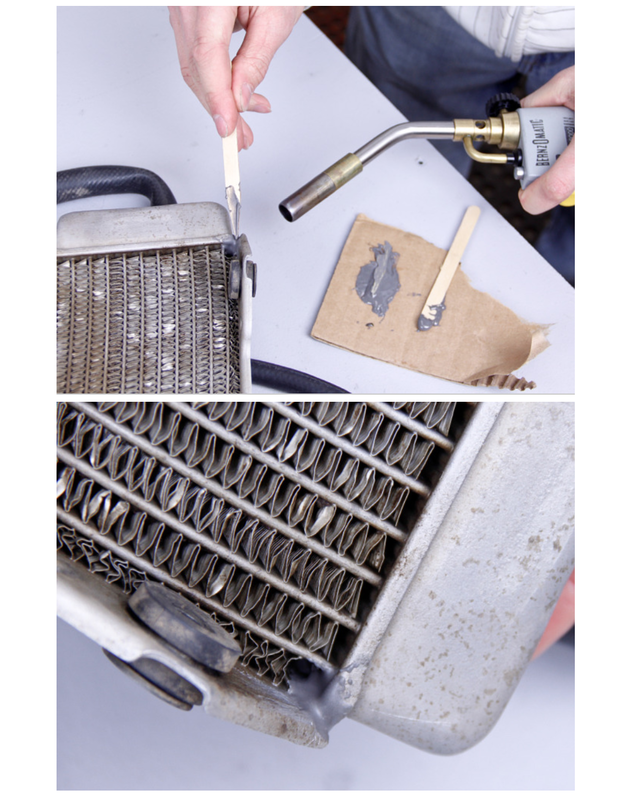How to Fix a Leaking Radiator
To fix a leaking radiator, identify the source of the leak and apply a radiator sealant for a temporary solution. Leaks can be fixed by tightening hose clamps or replacing damaged hoses.
Leaking radiators can cause low coolant levels and overheating, leading to potential engine damage and safety hazards. It’s essential to address radiator leaks promptly to ensure optimal vehicle performance. By following proper maintenance procedures and understanding common radiator issues, you can effectively troubleshoot and fix leaks before they escalate.
Regular checks and preventive measures can help prolong the lifespan of your radiator and prevent costly repairs down the line.

Credit: www.autozone.com
Identifying The Leakage
When dealing with a leaking radiator, the first step is to identify the source of the leakage. Pinpointing the exact location of the leak is crucial for effective repair. In this guide, we’ll discuss the different methods to identify and diagnose a leaking radiator.
Visible Signs Of A Leaking Radiator
If you notice puddles of coolant underneath your vehicle, or visible stains on the radiator itself, these are clear indicators of a leakage. Carefully inspect the area for any dampness or discoloration.
Checking For Coolant Drips
Often, a leaking radiator might manifest as drips of coolant under the car, especially when the vehicle has been stationary for a period. You can place a cardboard or clean sheet under the radiator area to monitor any drippage.
Inspecting The Radiator Cap
The radiator cap is a common area for potential leaks. Ensure that the cap is tightly sealed. Distorted or damaged caps can also cause leakage, so checking for any visible signs of wear or cracks is important.
Preparing For The Repair
Gathering The Necessary Tools And Supplies
Earmark all essentials before starting the repair.
Preparing The Work Area
Secure a clean, well-lit spot for the repair.
Draining The Coolant
Properly drain coolant to prevent spills and injuries.
Repairing The Radiator
Repairing the radiator is crucial to prevent further damage. To fix the issue effectively, you can consider the following methods.
Using A Radiator Stop Leak Product
One simple method is to use a radiator stop leak product. Add it to the radiator to seal minor leaks quickly.
Fixing Small Cracks Or Holes
Identify small cracks or holes on the radiator. Use a radiator repair kit to patch them securely.
Replacing Damaged Components
For more significant damage, consider replacing faulty components such as the radiator core or hoses.

Credit: m.youtube.com
Refilling And Testing The Radiator
Refilling and testing the radiator are essential steps to ensure that your vehicle’s cooling system is functioning optimally. Proper refilling of coolant and thorough testing for leaks and radiator performance can help prevent overheating and potential damage to your engine. In this section, we will cover the necessary steps for refilling coolant, bleeding air, testing for leaks, and checking radiator performance.
Refilling Coolant And Bleeding Air
When refilling the radiator with coolant, it’s crucial to follow the manufacturer’s guidelines for the correct coolant type and mixture. First, allow the engine to cool before removing the radiator cap to avoid potential burns from hot coolant. Then, carefully pour the coolant into the radiator up to the specified level, and ensure the overflow reservoir is filled to the appropriate mark. Once the coolant is added, it’s important to bleed any trapped air from the system to maintain proper circulation. This can be done by opening the bleeder valve, typically located near the thermostat housing, to release air as the coolant fills the system. Continue to add coolant as needed while bleeding the air until no air bubbles are observed, and then close the bleeder valve securely.
Testing For Leaks
After refilling the radiator, it’s essential to thoroughly test for any leaks. Inspect all hose connections, the radiator itself, and the water pump for any signs of leakage. For a more precise examination, a pressure testing kit can be used to pressurize the cooling system and identify any leaks. Check for dripping or pooling coolant underneath your vehicle after it has been running to identify any potential leaks that may not be visible during a static inspection.
Checking Radiator Performance
Once the radiator has been refilled and tested for leaks, it’s crucial to monitor its performance. Start the vehicle and allow it to reach operating temperature while observing the temperature gauge and listening for any unusual noises. Ensure that the cooling fan engages as the engine reaches the designated temperature, signalling that the cooling system is functioning properly. Additionally, monitor the temperature and coolant levels during normal vehicle operation to confirm that the radiator is effectively regulating the engine temperature. If any issues are detected, further investigation may be necessary to identify and resolve any underlying problems.
Seeking Professional Help
If you’re dealing with a leaking radiator, it’s essential to seek professional help to fix the issue effectively. A skilled technician can diagnose the problem and provide the necessary repairs, ensuring your radiator functions optimally and prevents any further leaks.
When Diy Efforts Fail
If you’ve tried fixing your leaking radiator yourself but haven’t had any luck, it may be time to seek professional help. DIY techniques can work for minor radiator leaks, but for more complex issues, you’ll need the expertise of a trained mechanic. Here are a few things to consider when your DIY efforts fail:
Finding A Reliable Mechanic
When it comes to choosing a mechanic to fix your leaking radiator, it’s important to find someone you can trust. Here are a few steps to help you find a reliable mechanic:
- Ask for Recommendations: Start by asking your friends, family, or colleagues if they can recommend a mechanic they have had a positive experience with.
- Read Online Reviews: Check online review sites to see what other customers have to say about different mechanics in your area. Look for consistent positive feedback and avoid those with numerous negative reviews.
- Verify Credentials: Make sure the mechanic you choose is licensed and certified to work on your specific make and model of vehicle. This will ensure they have the necessary knowledge and skills to fix your leaking radiator properly.
Once you’ve done your research and found a potential mechanic, don’t be afraid to ask questions about their experience with radiator repairs. A reliable mechanic will be confident in their abilities and willing to provide references or evidence of their expertise.
Remember, finding a reliable mechanic is essential for getting your leaking radiator fixed properly. Paying attention to these details will increase your chances of finding a mechanic you can trust.

Credit: www.diymotofix.com
Frequently Asked Questions Of How To Fix A Leaking Radiator
Can A Leaking Radiator Be Repaired?
Yes, a leaking radiator can be repaired by patching small holes or cracks, or replacing damaged parts. Regular maintenance can prevent leaks.
What To Do If A Radiator Is Leaking?
To fix a leaking radiator, turn off the heating, identify the leak source, tighten fittings if loose, and seal small cracks with radiator sealant. If the leak persists, consult a professional plumber for further assistance.
What Can I Put In My Radiator To Stop Leaks?
You can use a radiator stop leak solution to stop leaks in your radiator. It helps seal small cracks and holes effectively.
How Much Does It Cost To Fix A Radiator Leak?
The cost to fix a radiator leak varies depending on the extent of the damage. Simple repairs can range from $150 to $400, while more complex issues may cost between $500 and $900. It’s essential to consult a professional for an accurate estimate.
How Can I Tell If My Radiator Is Leaking?
If you notice puddles of coolant under your car or a decrease in coolant level, it’s likely your radiator is leaking.
What Are The Common Causes Of Radiator Leaks?
Corrosion, worn-out hoses, a cracked radiator tank, or a damaged radiator cap are common causes of radiator leaks.
Can I Fix A Leaking Radiator Myself?
If the leak is small and in an accessible area, you can fix it temporarily with a radiator sealant. However, it’s best to consult a professional for a permanent fix.
Conclusion
In a nutshell, fixing a leaking radiator is essential to prevent further damage in your vehicle. By paying attention to the signs and following these simple steps, you can effectively address any radiator leak. Remember to regularly maintain your car’s cooling system to ensure its longevity and optimal performance.
With these tips, you can tackle radiator leaks with confidence and keep your vehicle running smoothly.


